According to the U.S. Environmental Protection Agency, the average American spends 93% of their life indoors. Given this statistic, the health of our built environment—especially the workplace—is one of the hottest topics in our industry today, and we are seeing an increased interest in health and wellness as part of a sustainable strategy, focusing on healthy materials, air quality and active design. In response to the growing market demand for healthier buildings, the Centers for Disease Control and the General Services Administration developed Fitwel—a healthy building certification standard that optimizes building occupant health and productivity through targeted improvements to workplace design and policies. This cost-effective and high-impact certification standard allows buildings to be assessed against a baseline of evidence-based criteria that define a health-promoting environment. In today’s post, I take a closer look at Fitwel and how we have utilized this process in one of our most recent projects.
Understanding Fitwel
The Fitwel certification system is relatively simple and involves registering a building on a custom scorecard. Once a building is registered, users can complete the scorecard and acquire an instantaneous benchmark for the building. When the building is ready to be certified, users are asked to upload verification documents and submit for review. After the review is completed, a Fitwel rating of 1 to 3 stars is designated for the building. A Fitwel 3-star rating is the highest level achievable, denoting that the building incorporates an exemplary number of evidence-based design and policy strategies that support the physical, mental and social health of its occupants. Each strategy within the Fitwel Scorecard is linked by scientific evidence to at least one of seven Fitwel Health Impact Categories: Impacts Community Health; Promotes Occupant Safety; Instills Feelings of Well-being; Provides Healthy Food Options; Increases Physical Activity; Reduces Morbidity and Absenteeism; and Supports Social Equality for Vulnerable Populations.
The Fitwel Scorecard measures health within 12 overarching sections that impact the design and operations of a site and building interior. These comprise: Location; Building Access; Outdoor Spaces; Entrances and Ground Floor; Indoor Environment; Vending Machines and Snack Bars; Workspaces; Shared Spaces; Water Supply; Stairwells; Cafeterias and Prepared Food Retail; and Emergency Procedures. Below are some examples of how GS&P’s Corporate + Urban Design Studio integrated these impactful wellness strategies into Nashville’s new 25-floor mixed-use tower—and home to GS&P’s new headquarters—222 Second Avenue South:
Location
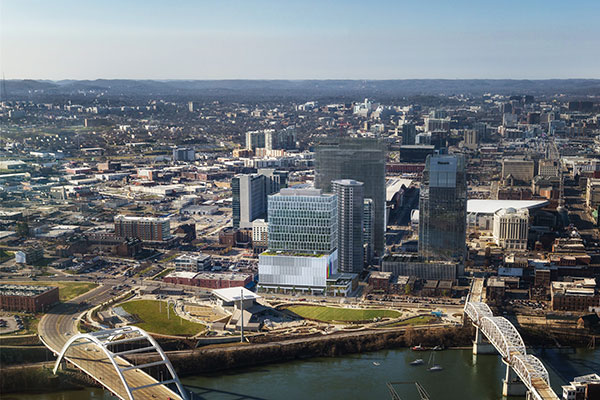
222 Second Avenue South is located in the heart of Nashville’s downtown SoBro neighborhood with easy access to transit, bicycle networks, walking paths, retail and food establishments. The location has a Walk Score of 75 (Very Walkable) and a Bike Score of 73 (Very Bikeable).
Building Access
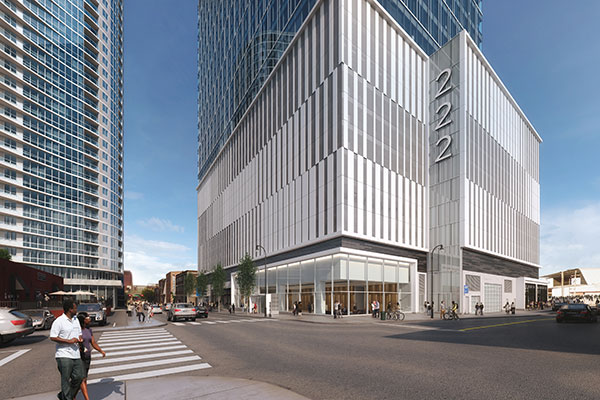
The mixed-use tower is in a pedestrian-friendly area of the city, with a direct pedestrian route between the main building entrance and public transit stops, bike networks and pedestrian routes. Accommodations are made for employees who wish to walk or bike to work.
Outdoor Spaces

A common terrace is located on the 12th floor for all building occupants to share. It overlooks Cumberland Park along downtown Nashville’s scenic riverfront—another great outdoor space for employees to utilize. The terrace is smoke-free and features a combination of vegetated and paved areas, including a lawn for activities such as cornhole or yoga, and fixed seating for working outside or enjoying lunch.
Entrances and Ground Floor

The building entrance is located to allow easy pedestrian access and incorporates publicly accessible uses on the first floor, including retail and food options. Signage at all building entrances designates the building as smoke-free.
Stairwells
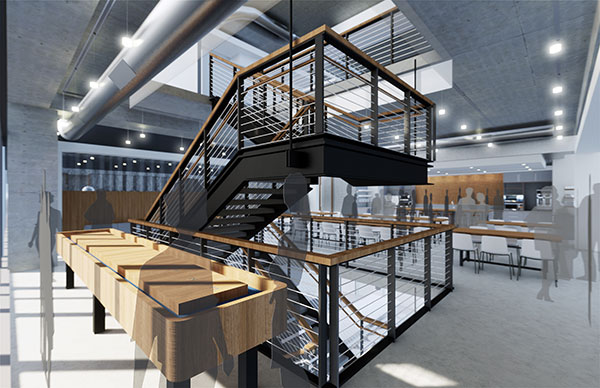
An internal communicating stair connects all three GS&P floors at the hubs. The stairwell is centrally located, easily visible and an active part of the overall design.
Workspaces
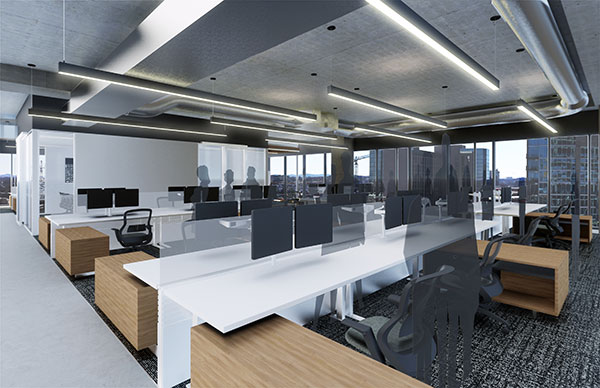
Workspaces have abundant access to natural daylight and views to the outdoors. All employees have height-adjustable workstations. The indoor environment is smoke-free, with low-VOC materials used throughout. Ventilation requirements were a specific part of the design.
Shared Spaces
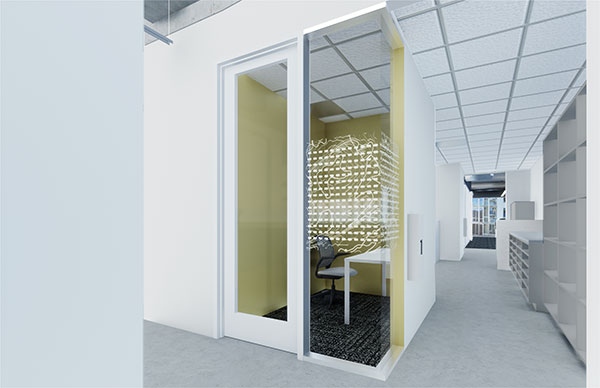
Break areas are located at the hubs. Multipurpose rooms are available throughout, and each floor features a private lactation room. Quiet rooms and enclaves are also available for employees to use in private. A dedicated exercise room is located on the 12th floor for use by building occupants.
Water Supply
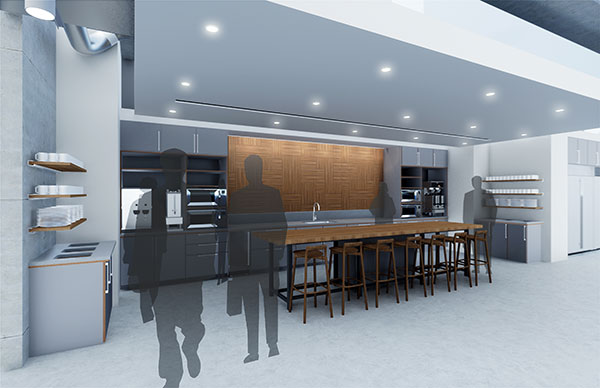
Access to healthy water—the base building has bottle fillers at each water fountain station. GS&P’s space features our standard filtered water dispensers in each hub.
Cafeterias and Prepared Food Retail
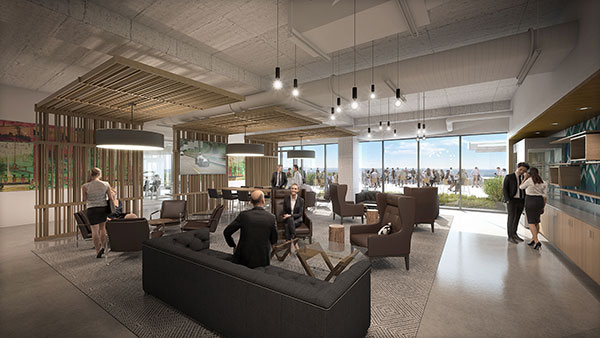
The 12th-floor common area has a “Grab and Go Café” featuring healthy food options.
A Happier, More Productive Workforce
By successfully adopting Fitwel’s evidenced-based strategies into the 222 Second Avenue South tower, GS&P not only enhances the human experience by providing a healthy building for its occupants, but also adds value to the tenants of the space by incorporating attributes of the built environment that make for a happier, more productive workforce. With this increased focus on human health in the built environment, the three-legged stool of sustainability—resting on social, economic and environmental supports—has become much more equally weighted.
More from Author
Gresham Smith | Oct 16, 2024
How AI can augment the design visualization process
Blog author Tim Beecken, AIA, uses the design of an airport as a case-study for AI’s potential in design visualizations.
Gresham Smith | Aug 17, 2023
How to design for adaptive reuse: Don’t reinvent the wheel
Gresham Smith demonstrates the opportunities of adaptive reuse, specifically reusing empty big-box retail and malls, many of which sit unused or underutilized across the country.
Gresham Smith | May 24, 2023
Designing spaces that promote enrollment
Alyson Mandeville, Higher Education Practice Leader, argues that colleges and universities need to shift their business model—with the help of designers.
Gresham Smith | Apr 24, 2023
Smart savings: Commissioning for the hybrid workplace
Joe Crowe, Senior Mechanical Engineer, Gresham Smith, shares smart savings tips for facility managers and building owners of hybrid workplaces.
Gresham Smith | Mar 20, 2023
3 ways prefabrication doubles as a sustainability strategy
Corie Baker, AIA, shares three modular Gresham Smith projects that found sustainability benefits from the use of prefabrication.
Gresham Smith | Jan 19, 2023
Maximizing access for everyone: A closer look at universal design in healthcare facilities
Maria Sanchez, Interior Designer at Gresham Smith, shares how universal design bolsters empathy and equity in healthcare facilities.
Gresham Smith | Dec 20, 2022
Designing for a first-in-the-world proton therapy cancer treatment system
Gresham Smith begins designing four proton therapy vaults for a Flint, Mich., medical center.
Gresham Smith | Nov 21, 2022
An inside look at the airport industry's plan to develop a digital twin guidebook
Zoë Fisher, AIA explores how design strategies are changing the way we deliver and design projects in the post-pandemic world.
Gresham Smith | Feb 13, 2022
Helping maximize project dollars: Utility coordination 101
In this post, I take a look at the utility coordination services our Transportation group offers to our clients in an attempt to minimize delays and avoid unforeseen costs.
Gresham Smith | May 7, 2021
Private practice: Designing healthcare spaces that promote patient privacy
If a facility violates HIPAA rules, the penalty can be costly to both their reputation and wallet, with fines up to $250,000 depending on the severity.
















